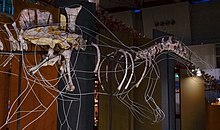| Ichthyovenator Temporal range: Early Cretaceous, (Aptian)
| |
|---|---|

| |
| Mounted holotype skeleton at the National Museum of Nature and Science, Tokyo | |
| Scientific classification | |
| Domain: | Eukaryota |
| Kingdom: | Animalia |
| Phylum: | Chordata |
| Clade: | Dinosauria |
| Clade: | Saurischia |
| Clade: | Theropoda |
| Family: | †Spinosauridae |
| Subfamily: | †Spinosaurinae |
| Genus: | †Ichthyovenator Allain et al., 2012 |
| Type species | |
| †Ichthyovenator laosensis Allain et al., 2012
| |
Ichthyovenator is a genus of spinosaurid dinosaur that lived in what is now Laos, sometime between 120 and 113 million years ago, during the Aptian stage of the Early Cretaceous period. It is known from fossils collected from the Grès supérieurs Formation of the Savannakhet Basin, the first of which were found in 2010, consisting of a partial skeleton without the skull or limbs. This specimen became the holotype of the new genus and species Ichthyovenator laosensis, and was described by palaeontologist Ronan Allain and colleagues in 2012. The generic name, meaning "fish hunter", refers to its assumed piscivorous lifestyle, while the specific name alludes to the country of Laos. In 2014, it was announced that more remains from the dig site had been recovered; these fossils included teeth, more vertebrae (backbones) and a pubic bone from the same individual.
The holotype specimen is estimated to have been between 8.5 to 10.5 metres (28 to 34 feet) long and to have weighed 2.4 tonnes (2.6 short tons; 2.4 long tons). Ichthyovenator's teeth were straight and conical, and its neck resembled that of the closely related genus Sigilmassasaurus ( Which may be synonymus with Spinosaurus). Like others in its family, Ichthyovenator had tall neural spines that formed a sail on its back. Unlike other known spinosaurids, Ichthyovenator's sail had a sinusoidal (wave-like) shape that curved downwards over the hips and divided into two separate sails. The pelvic girdle was reduced; the ilium—the uppermost body of the pelvis—was proportionately longer than both the pubis and ischium than in other known theropod dinosaurs. Ichthyovenator was initially thought to belong to the subfamily Baryonychinae but more recent analyses place it as a primitive member of the Spinosaurinae.
As a spinosaur, Ichthyovenator would have had a long, shallow snout and robust forelimbs. Its diet likely mainly consisted of aquatic prey, hence its etymology. Spinosaurids are also known to have eaten small dinosaurs and pterosaurs in addition to fish. Ichthyovenator's conspicuous sail might have been used for sexual display or species recognition. Fossil evidence suggests spinosaurids, especially spinosaurines, were adapted for semiaquatic lifestyles. The vertebral spines of Ichthyovenator's tail were unusually tall, suggesting—as in today's crocodilians—the tail may have aided in swimming. Ichthyovenator lived alongside sauropod and ornithopod dinosaurs, as well as bivalves, fish and turtles.